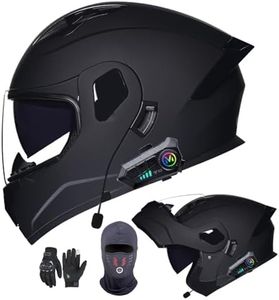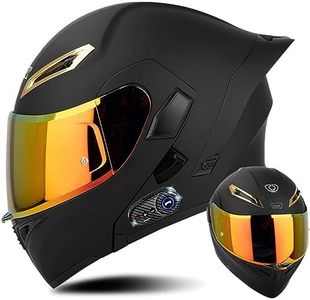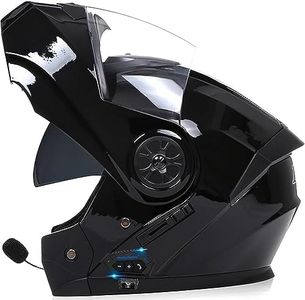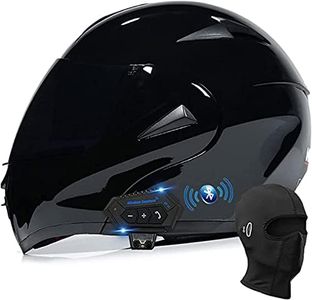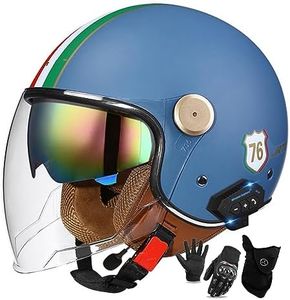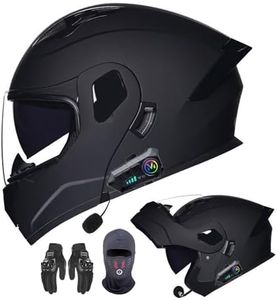We Use CookiesWe use cookies to enhance the security, performance,
functionality and for analytical and promotional activities. By continuing to browse this site you
are agreeing to our privacy policy
6 Best Bluetooth Motorcycle Helmets
From leading brands and best sellers available on the web.Buying Guide for the Best Bluetooth Motorcycle Helmets
Choosing a Bluetooth motorcycle helmet is all about finding the right balance between comfort, connectivity, safety, and practicality for your riding style. Since these helmets include built-in communication systems, it’s important to look beyond just the fit and shape, and also consider how easily you can stay connected while on the road. Think about your typical rides: Are they short city commutes or long highway trips? Do you want to stay in touch with other riders, take calls, or simply listen to music? Knowing your needs helps you focus on features that truly make a difference for your experience and enjoyment.Bluetooth VersionBluetooth version refers to the wireless communication standard used by the helmet’s built-in system. Newer versions (like Bluetooth 5.0 and above) offer better range, stronger connection, and improved battery efficiency, while older versions (like 3.0 or 4.0) may have more limited features. If you plan to connect your helmet to modern smartphones, GPS, or multiple devices, a recent Bluetooth version is essential. However, for basic tasks like phone calls or solo music playback, even an older version may suffice. Consider your device compatibility and how much you value stable, multi-device connections when choosing.
Battery LifeBattery life measures how long the helmet's Bluetooth system can operate on a single charge, often specified for both talk time and standby time. Longer rides and frequent use of intercom or music features will require a helmet with extended battery life (talk time may range from a few hours up to 20+ hours). If you ride short distances or don’t use Bluetooth features constantly, shorter battery life might be acceptable. Think about your usual ride duration and how often you want to charge your helmet to determine what kind of battery life will keep you connected without hassle.
Intercom RangeIntercom range is the maximum distance over which you can communicate with other riders using the helmet's built-in intercom feature. Some helmets support only a few hundred meters, while advanced ones can manage up to several kilometers, especially in open and unobstructed environments. If you often ride in groups and need to stay in contact over long distances, a helmet with greater intercom range is ideal. For occasional or close-range communication, a shorter range may be acceptable. Consider your group riding habits and typical riding environments when evaluating this feature.
Helmet Type and FitThis refers to the overall design and shape of the helmet, such as full-face, modular (flip-up), or half-helmet styles. Each offers a different level of protection, comfort, and suitability for Bluetooth installations. Full-face and modular designs generally integrate Bluetooth components better, offering more space for speakers and microphones and better noise isolation. Make sure to try helmets for comfort and fit, as a well-fitting helmet is crucial for safety and proper functioning of the Bluetooth features. Pick a style that matches your riding and personal habits: more aggressive riding may require a full-face helmet, while leisurely rides might be suited for modular or open-face options.
Speaker and Microphone QualityThe quality of the built-in speakers and microphones greatly impacts your ability to hear and be heard clearly, especially at high speeds or in noisy environments. Higher-end helmets often use noise-cancelling microphones and better speakers for crisp audio during calls or music playback. If you value crystal-clear communication or want to enjoy music while riding, pay attention to user reviews and specifications related to audio quality. Occasional users who mainly answer calls at low speed can compromise a little on this feature, but frequent communicators or music lovers should look for top-quality audio equipment.
Safety CertificationsSafety certifications (like DOT, ECE, or Snell) indicate that the helmet meets certain protective standards. This spec doesn’t change with Bluetooth integration—it’s still vital that your helmet is certified for the regions where you ride. Only consider helmets that have at least one recognized certification. While all Bluetooth helmets should be safe, always verify this before making your decision, as the primary job of the helmet is to protect you in an accident.
Ease of ControlsEase of controls refers to how simple it is to operate the helmet's Bluetooth functions while riding. Controls can be buttons, dials, or even voice-activated systems, usually located where you can reach them with gloves on. If you plan to make frequent adjustments (like changing music, answering calls, or switching intercom channels), look for intuitive and easily accessible controls. Simpler or less distracting controls make riding safer and Bluetooth functions more enjoyable. Think about how comfortable you would be using these controls at speed or with gloves when choosing your helmet.
Weather ResistanceWeather resistance determines how well the helmet's electronic components, such as the Bluetooth hardware, stand up to exposure to rain, dust, and temperature changes. Helmets with higher weather resistance will be more durable and reliable for riders who frequently encounter bad weather or varying climates. If you often ride in harsh conditions, make sure your helmet is labeled as water-resistant or weatherproof, so you won’t have to worry about malfunctioning Bluetooth systems during your rides. If you ride mostly in good weather, this may be less critical.
